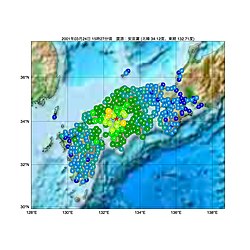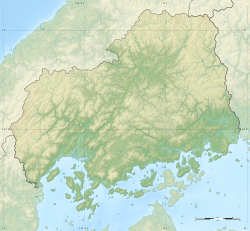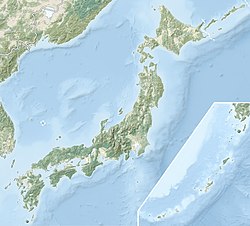The 2001 Geiyo earthquake (2001年芸予地震 Nisen-ichi-nen Gēyo Jishin) occurred with a moment magnitude of 6.7 on March 24 at 15:27 local time near Hiroshima, Japan. One person in Hiroshima and one person in Ehime were reported dead. About 3,700 buildings were damaged in the Hiroshima area.[2] Liquefaction was observed in Hiroshima[3] and Ehime.[4] Power outages occurred in the prefectures of Hiroshima, Ehime, Okayama, Yamaguchi, and Kōchi. The maximum intensity was shindo lower 6 in Hiroshima.[5] This earthquake could be felt along the eastern and southern coasts of South Korea.[6]
 | |
| UTC time | 2001-03-24 06:27:53 |
|---|---|
| ISC event | 1800460 |
| USGS-ANSS | ComCat |
| Local date | March 24, 2001 |
| Local time | 15:27 |
| Magnitude | 6.7 Mw |
| Depth | 50 km |
| Epicenter | 34°04′59″N 132°31′34″E / 34.083°N 132.526°E |
| Type | Normal |
| Areas affected | Japan |
| Max. intensity | MMI IX (Violent)[1] JMA 6− |
| Casualties | 2 killed, 288 injured |
The released seismic moment of the earthquake was 1.3×1019 Nm. This earthquake is a normal faulting intraslab event within the subducting Philippine Sea plate.[7] The slip of the earthquake was estimated to be about 1.5–2.4 meters (4 ft 11 in – 7 ft 10 in). The locations of aftershocks were distributed roughly in N–S direction.[8] It has been suggested that this earthquake was related to the dehydration of the Philippine Sea plate slab.[9]
In this region, a strong earthquake occurred in 1905, which was also an intraslab event within the subducting plate.[10]
See also
editReferences
edit- ^ National Geophysical Data Center / World Data Service (NGDC/WDS) (1972). "Significant Earthquake Database" (Data Set). National Geophysical Data Center, NOAA. doi:10.7289/V5TD9V7K.
- ^ "Significant Earthquakes of the World 2001". United States Geological Survey. Archived from the original on April 25, 2015.
- ^ Yoshimine, M. "2001 Geiyo Earthquake, Japan". Soil Mechanics Laboratory, Civil Engineering, Tokyo Metropolitan University. Archived from the original on 2012-07-11. Retrieved 2012-01-10.
- ^ Sakakibara, Masayuki; Inouchi, Yoshio; Nara, Masakazu (2002). "Liquefaction of reclaimed land in Toyo City, Ehime Prefecture, by the 2001 Geiyo earthquake". Journal of the Geological Society of Japan. 108 (6): XIII–XIV. doi:10.5575/geosoc.108.XIII.
- ^ "平成13年(2001年)芸予地震について(About Geiyo Earthquake in 2001)" (PDF) (in Japanese). Archived from the original (PDF) on 2011-10-27. Retrieved 2012-01-10.
- ^ Hall, K. "At least two die as strong earthquake hits Japan". The Independent. Archived from the original on 28 July 2014.
- ^ Miyatake, T.; Yagi, Y.; Yasuda, T. (2004). "The dynamic rupture process of the 2001 Geiyo, Japan, earthquake". Geophysical Research Letters. 31 (12): L12612. Bibcode:2004GeoRL..3112612M. doi:10.1029/2004GL019721.
- ^ "平成13年(2001年)芸予地震(2001年3月24日,M6.7) (2001 Geiyo Earthquake (March 24, 2001, M6.7))" (PDF) (in Japanese).
- ^ Zhao, D.; Mishra, O.P.; Sanda, R.; Obara, K.; Umino, N.; Hasegawa, A. (2001). "Seismological Evidence for the Influence of Fluids and Magma on Earthquakes" (PDF). Bulletin of the Earthquake Research Institute University of Tokyo. 76: 271–289. Archived from the original (PDF) on 2014-07-28. Retrieved 2012-01-10.
- ^ Hiroshima Crisis Management Supervision, Crisis Management Division . "災害に備えて:地震・津波災害とは (Preparing for a disaster: What is an earthquake / tsunami disaster?)" (in Japanese). Archived from the original on 2013-10-29. Retrieved 2012-05-12.
External links
edit- The International Seismological Centre has a bibliography and/or authoritative data for this event.

